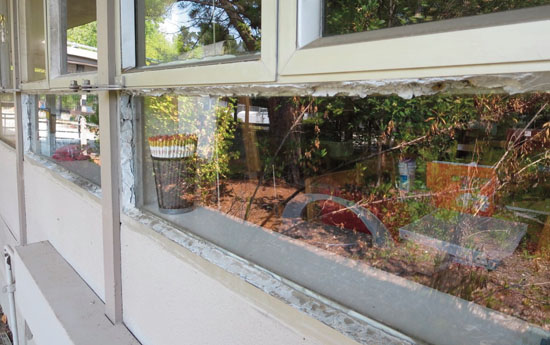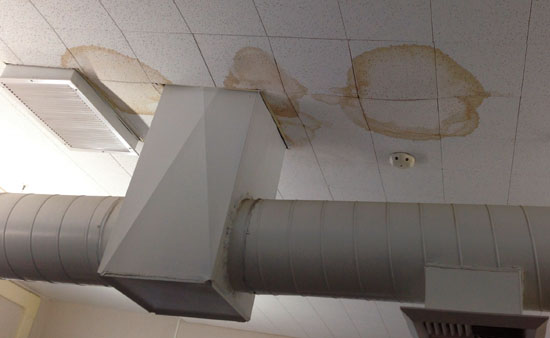 | | | Deteriorating window casing at one Lafayette school. Photo provided | | | | | | It appears that the Lafayette School District completed all of its homework before its due date: In an extensive group effort over the past 18 months, teachers, staff and parents, along with consultants and an architecture team, thoroughly assessed all of the facilities that make up the five district campuses and compiled a long list of many troubling infrastructure issues.
 Faced with aging schools, and an ever increasing number of students, the governing board is set to authorize placing a $70 million bond measure on the June 7 ballot at their March 9 meeting.
Faced with aging schools, and an ever increasing number of students, the governing board is set to authorize placing a $70 million bond measure on the June 7 ballot at their March 9 meeting.
 Residents may be unaware just how old these schools are: Lafayette Elementary School opened in 1943 and has approximately 550 students; Burton Valley Elementary opened in 1957 and has almost 800 students; and Stanley Middle School opened in 1955 and has 1,270 students.
Residents may be unaware just how old these schools are: Lafayette Elementary School opened in 1943 and has approximately 550 students; Burton Valley Elementary opened in 1957 and has almost 800 students; and Stanley Middle School opened in 1955 and has 1,270 students.
 The bond would cost property owners no more than $30 per $100,000 of assessed value of their taxable property and needs 55 percent voter approval to pass. Safeguards are built into the measure with an independent citizen's oversight committee, annual audits, all revenue to stay local and no funding for administrator salaries.
The bond would cost property owners no more than $30 per $100,000 of assessed value of their taxable property and needs 55 percent voter approval to pass. Safeguards are built into the measure with an independent citizen's oversight committee, annual audits, all revenue to stay local and no funding for administrator salaries.
 With no other facility funding coming from the state, the district, which includes four elementary schools - Burton Valley, Happy Valley, Lafayette, and Springhill - along with Stanley Middle School, is on its own.
With no other facility funding coming from the state, the district, which includes four elementary schools - Burton Valley, Happy Valley, Lafayette, and Springhill - along with Stanley Middle School, is on its own.
 Superintendent Rachel Zinn said, "There's a tremendous amount of need" due to wear and tear from decades of constant use at every campus. She explained that safe modern schools are essential to protecting the outstanding quality of local neighborhood schools and that the longer the district waits to remedy the laundry list of renovations and repairs, the more expensive it was going to be.
Superintendent Rachel Zinn said, "There's a tremendous amount of need" due to wear and tear from decades of constant use at every campus. She explained that safe modern schools are essential to protecting the outstanding quality of local neighborhood schools and that the longer the district waits to remedy the laundry list of renovations and repairs, the more expensive it was going to be.
 HKIT Architects proposed a long project list, covering renovation or replacement of aging, deteriorated building systems and infrastructure at each of the schools. Specific items include aging roofs, plumbing, lighting, heating ventilation and air conditioning, site utilities - sewer, water, and electrical services - classrooms, walls, ceilings, floor coverings, siding, paint windows, fire alarm systems, parking lots and more.
HKIT Architects proposed a long project list, covering renovation or replacement of aging, deteriorated building systems and infrastructure at each of the schools. Specific items include aging roofs, plumbing, lighting, heating ventilation and air conditioning, site utilities - sewer, water, and electrical services - classrooms, walls, ceilings, floor coverings, siding, paint windows, fire alarm systems, parking lots and more.
 The board concluded from all the information gathered, including a structural evaluation, a public financial management presentation, a capacity and utilization study along with long-range enrollment projections, that critical facilities at all of the campuses that educate Lafayette students from kindergarten through eighth grade must be addressed.
The board concluded from all the information gathered, including a structural evaluation, a public financial management presentation, a capacity and utilization study along with long-range enrollment projections, that critical facilities at all of the campuses that educate Lafayette students from kindergarten through eighth grade must be addressed.
 The Lafayette School District has not had a bond measure since 1995, although the Acalanes Union High School District has had measures that were passed by voters in 1988, 1997, and 2002. However, voters in 2014 approved Measure B, a parcel tax extension for the Lafayette School District, which continued existing tax rates without an increase.
The Lafayette School District has not had a bond measure since 1995, although the Acalanes Union High School District has had measures that were passed by voters in 1988, 1997, and 2002. However, voters in 2014 approved Measure B, a parcel tax extension for the Lafayette School District, which continued existing tax rates without an increase.
 For more information on all the studies the bond measure is based upon, go to the Lafayette School District website, www.lafsd.k12.ca.us, click on District, then select Facilities Master Planning Resources from the drop down list.
For more information on all the studies the bond measure is based upon, go to the Lafayette School District website, www.lafsd.k12.ca.us, click on District, then select Facilities Master Planning Resources from the drop down list.

|

